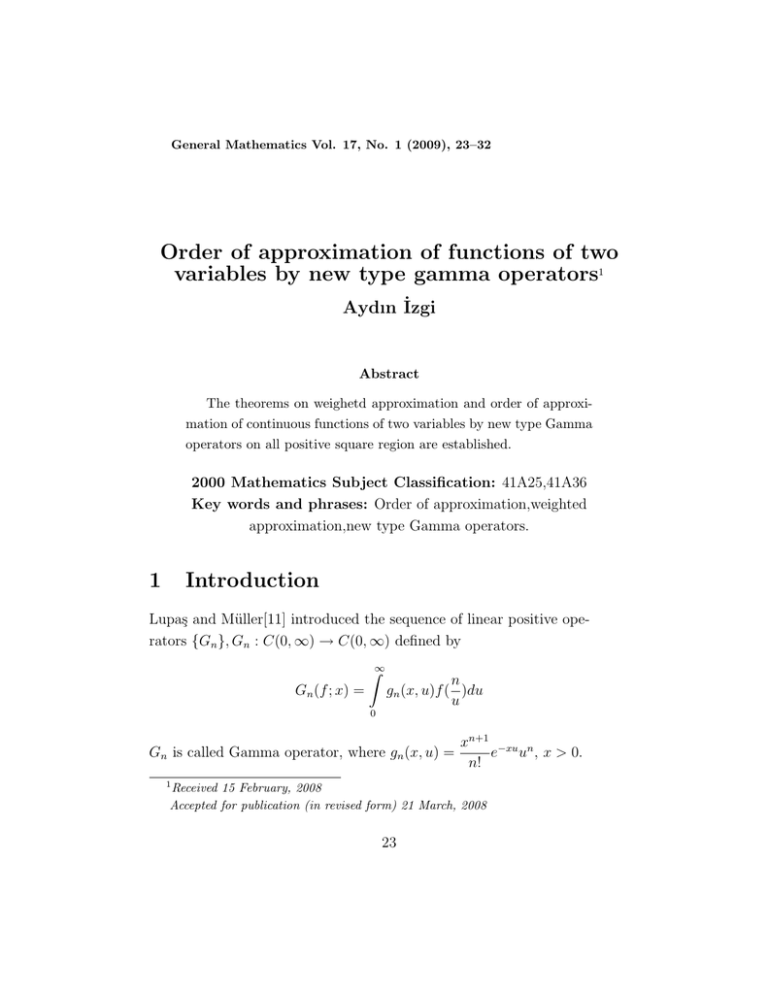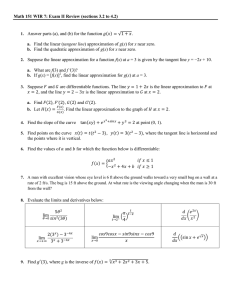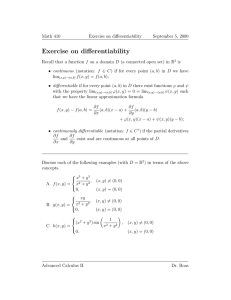Order of approximation of functions of two Aydın ˙Izgi
advertisement

General Mathematics Vol. 17, No. 1 (2009), 23–32
Order of approximation of functions of two
variables by new type gamma operators1
Aydın İzgi
Abstract
The theorems on weighetd approximation and order of approximation of continuous functions of two variables by new type Gamma
operators on all positive square region are established.
2000 Mathematics Subject Classification: 41A25,41A36
Key words and phrases: Order of approximation,weighted
approximation,new type Gamma operators.
1
Introduction
Lupaş and Müller[11] introduced the sequence of linear positive operators {Gn }, Gn : C(0, ∞) → C(0, ∞) defined by
Gn (f ; x) =
Z∞
n
gn (x, u)f ( )du
u
0
Gn is called Gamma operator, where gn (x, u) =
1
xn+1 −xu n
e u , x > 0.
n!
Received 15 February, 2008
Accepted for publication (in revised form) 21 March, 2008
23
24
Aydın İzgi
Mazhar [12] used same gn (x, u) of Gamma operator and introduced the
following sequence of linear positive operators:
Z∞
Fn (f ; x) =
gn (x, u)du
0
Z∞
gn−1 (u, t)f (t)dt
0
(2n)!xn+1
=
n!(n − 1)!
Z∞
tn−1
f (t)dt, n > 1, x > 0
(x + t)2n+1
0
for any f which the last integral is convergent. Now we will modify the operators Fn (f ; x) as the following operators An (f ; x) (see [9]) which confirm
An (t2 ; x) = x2 . Many linear operators Ln (f ; x) confirm, Ln (1; x) = 1,
Ln (t; x) = x but don’t confirm Ln (t2 ; x) = x2 (see [2],[10]).
An (f ; x) =
Z∞
gn+2 (x, u)du
gn (u, t)f (t)dt
0
0
=
Z∞
(2n + 3)!xn+3
n!(n + 2)!
Z∞
tn
f (t)dt, x > 0
(x + t)2n+4
0
If we choose
Kn (x, t) =
(2n + 3)! xn+3 tn
, x, t ∈ (0, ∞),
n!(n + 2)! (x + t)2n+4
we can show An (f ; x) as the following form:
(1)
An (f ; x) =
Z∞
Kn (x, t)f (t)dt.
0
In this study we will investigate approximation and order of approximation of the following operators which defined for two variables functions.
(2)
An,m (f ; x, y) =
Z∞
0
Kn,m (x, t; y, u)f (t, u)dtdu
Order of approximation...
25
where Kn,m (x, t; y, u) = Kn (x, t) × Km (y, u).
It can be easily to see that:
An,m (f ; x, y) = An (f1 ; x) + Am (f2 ; y) ; if f (t, u) = f1 (t) + f2 (u)
An,m (f ; x, y) = An (f1 ; x) × Am (f2 ; y) ; if f (t, u) = f1 (t) × f2 (u)
Thus for any p, q ∈ N, p ≤ n and q ≤ m, we can see the following
equalities (see [9]):
(3)
(4)
(5)
(6)
An,m (1; x, y) = 1
An,m (t + u; x, y) = x + y −
y
x
−
n+2 m+2
An,m (t2 + u2 ; x, y) = x2 + y 2
An,m (t3 + u3 ; x) = x3 + y 3 +
(7) An,m (t4 +u4 ; x) = x4 +y 4 +
3 3
3
x + y3
n
m
4(2n + 3) 4 4(2m + 3) 4
x +
y , n > 1, m > 1.
n(n − 1)
m(m − 1)
(8)
An,m ({t + u} − {x + y}); x, y) = −
x
y
−
n+2 m+2
(9)
An,m ({(t − x)2 + (u − y)2 }; x, y) =
2y 2
2x2
+
n+2 m+2
(10)
An,m ({(t − x)4 + (u − y)4 }; x, y) =
12(n + 4)
x4
(n + 2)n(n − 1)
12(m + 4)y 4
+
, n > 1, m > 1
(m + 2)m(m − 1)
26
Aydın İzgi
Let C(R2 ) be the set of all real-valued functions of two variables continuous on R2 := {(x, y) : x ≥ 0, y ≥ 0}, σ(x, y) = 1 + x2 + y 2 , −∞ < x, y <
∞ and Bσ be sets of all functions f defined on R2 satisfying the condition
(11)
| f (x, y)| ≤ Mf σ(x, y)
where Mf is a constant depending only on f and the norm is defined by
kf kσ = sup
(x,y)∈R2
| f (x, y)|
.
σ(x, y)
Cσ denotes the subspaces of all continuous functions which belonging to
Bσ and Cσk denotes the subspaces of all functions belonging to Cσ with
f (x, y)
= k < ∞,
x,y→∞ σ(x, y)
lim
where k is a constant depending only on f.
The approximation theorems for two variables are proved by Volkov[13].
He proved the theorem:
Theorem A ([13]). If {Tn } is a sequence of linear positive operators satisfying the conditions
lim kTn (1; x1 , x2 ) − 1kC(X) = 0 .
n→∞
lim kTn (ti ; x1 , x2 ) − xi kC(X) = 0, i = 1, 2 .
lim Tn (t21 + t22 ; x1 , x2 ) − (x21 + x22 )C(X) = 0 .
n→∞
n→∞
then for any function f ∈ C(X), which is bounded in R2
lim kTn (f ; x1 , x2 ) − f (x1 , x2 )kC(X) = 0 .
n→∞
where X is a compact set.
Gadzhiev proved the following theorem for one variable functions.
Theorem B ([3, 4]). {Tn } be the sequence of linear positive operators which
mapping from Cρ into Bρ satisfying the conditions
lim kTn (tv ; x) − xv kρ = 0, v = 0, 1, 2.
n→∞
Order of approximation...
27
Then , for any f ∈ Cρk ,
lim kTn f − f kρ = 0.
n→∞
and there exist a function f ∈ Cρ \ Cρk such that
lim kTn f − f kρ ≥ 1.
n→∞
Analogously as in Theorem B, the theorems on weighted approximation
for functions of several variables are proved by Gadzhiev [5].
Applying Theorem B to the operators
Tn (f ; x) =
(
Vn (f ; x), if x ∈ [0, an ]
f (x), if x > an
one then also has the following theorem.
Theorem C ([6]). Let (an ) be a sequence with lim an = ∞ and {Vn } be a
n→∞
sequence of linear positive operators taking Cρ [0, an ] into Bρ [0, an ].
If for v = 0, 1, 2
lim kVn (tv ; x) − xv kρ,[0,an ] = 0,
n→∞
then for any f ∈ Cρk [0, an ]
lim kVn f − f kρ,[0,an ] = 0,
n→∞
where Bρ [0, an ], Cρ [0, an ] and Cρk [0, an ] denote the same as Bρ , Cρ and Cρk
respectively, but the functions taken on [0, an ] instead of R and the norm is
taken as
|f (x)|
.
kf kρ,[0,an ] = sup
x∈[0,an ] ρ(x)
28
Aydın İzgi
2
Approximation of An,m
Let (bn ) is be a sequence has positive terms, increasing and has the following
conditions,
(12)
lim bn = ∞
n→∞
and
b2n
=0
n→∞ n
lim
We will denote the rectangular region (0, bn ] × (0, bm ] by Dn,m and let
Bσ (Dn,m ) be sets of all functions f defined on Dn,m satisfying the condition
(11)
By the using (3) and (5), we have
An,m (σ(t, u); x, u) = σ(x, y).
Therefore, kAn,m (f ; x)kσ(Dn,m ) is uniformly bounded on Dn,m . Hence
{An,m } is a sequence of linear positive operators taking Cσ (Dn,m ) into
Bσ (Dn,m ) .
Theorem 1. Let f ∈ Cσk , then
lim kAn,m (f ; x, y) − f (x, y)kσ(Dn,m ) = 0.
n,m→∞
Proof.
lim kAn,m (1; x, y) − 1kσ(Dn,m ) = 0.
n,m→∞
x
n + 2 = 0.
lim kAn,m (t; x, y) − xkσ = lim
sup
n,m→∞
n,m→∞ (x,y)∈(D
σ(x, y)
n,m )
y
m + 2 = 0.
lim kAn,m (u; x, y) − ykσ = lim
sup
n,m→∞
n,m→∞ (x,y)∈(D
σ(x, y)
n,m )
lim An,m (t2 + u2 ; x, y) − (x2 + y 2 )σ(Dn,m ) = 0
n,m→∞
Similar to Theorem B we obtain the desired results.
Order of approximation...
3
29
The Order of Approximation of An,m
We now want to find the degree of approximation of functions f ∈ Cσk by
the operators An,m on Dn,m . It is well- known that the usual first modulus
of continuity
o
n
p
̟(f ; δ) = sup |f (t, u) − f (x, y)| : (t − x)2 + (u − y)2 ≤ δ; t, u, x, y ∈ [a, b]
don’t tend to zero, as δ → 0, on any infinite interval and any infinite area,
respectively.
In [8] was defined the weighted modulus of continuity for f ∈ Cσk as the
following (see also [1]):
Λ(f ; δ, η) = sup
|f (x + t, y + u) − f (x, y)|
: x, y ∈ R2 , |t| ≤ δ, |u| ≤ η
σ(x, y)σ(t, u)
Λ(f ; δ, η) is having the following properties:
lim Λ(f ; δ, η) = 0.
δ,η→0
Λ(f ; λ1 δ, λ2 η) ≤ 4(1 + λ1 )(1 + λ2 )Λ(f ; δ, η), for λ1 > 0, λ2 > 0
and
(13)
|f (t, u) − f (x, y)| ≤ 8(1 + x2 + y 2 )Λ(f ; δn , δm )(1 +
|t − x|
|u − y|
)(1 +
)
δn
δm
×(1 + (t − x)2 )(1 + (u − y)2 )
Theorem 2. For every f ∈ Cσk the inequality
sup
(x,y)∈Dn,m
|An,m (f ; x, y) − f (x, y)|
≤ 4232Λ(f ;
(1 + x2 + y 2 )
is true for all n, m sufficiently large.
s
2b2n
n+2
,
s
2b2m
)
m+2
30
Aydın İzgi
Proof. If we use (13) and (3) we have
|An,m (f ; x, y) − f (x, y)| ≤ 8(1 + x2 + y 2 )Λ(f ; δn , δm )
|t − x|
|u − y|
×An,m ((1 +
)(1 +
)(1 + (t − x)2 )(1 + (u − y)2 ); x, y)
δn
δm
≤ 8(1 + x2 + y 2 )Λ(f ; δn , δm )
|u − y|
|t − x|
)(1 + (t − x)2 ); x) × Am ((1 +
)(1 + (u − y)2 ); y)
×An ((1 +
δn
δm
a2 + b 2
We know that a.b ≤
is hold for all positive real numbers a and
2
b. Thus, apply equalities (3), (9), (10) and Cauchy-Schwarz inequalities, we
will get
|An,m (f ; x, y) − f (x, y)|
≤
(1 + x2 + y 2 )
#
"
r
1 2x2
1
1
2x2
12(n + 4)
Λ(f ; δn , δm ) × 1 + (1 +
+
+
x4
)
2δn n + 2 δn n + 2 2δn (n + 2)n(n − 1)
"
#
r
1
2y 2
12(m + 4)
1
2y 2
1
× 1 + (1 +
)
+
+
y4
2δm m + 2 δm m + 2 2δm (m + 2)m(m − 1)
r
r
2b2n
2b2m
and δm =
and consider δn ≤ 1,
Choosing δn =
n+2
m+2
b2
δm ≤ 1 for all n, m sufficiently large since lim n = 0 , we obtain the
n→∞ n
desired result.
References
[1] N. I. Achieser, Lectures on the theory of approximation, OGIZ, MoscowLeningrad, 1947(in Russian), Theory of approximation (in English),
Translated by Hymann,C. J., Frederick Ungar Publishing Co. New
York, 1956.N. 1967, 208-226.
[2] O. Agratini, On class of linear positive bivariate operators of King, Studia Univ.”Babeş-Bolyai”, Mathematica, Vol.L1,No:1,December 2006.
Order of approximation...
31
[3] A.D.Gadzhiev, Theorems of the type P.P. Korovkin theorems, Math.Zametki 20(5)(1976) 781-786.English translation in
Math.Notes 20(5-6) (1976) 996-998.
[4] A.D.Gadzhiev, The convergence problem for a sequence of linear operators on unbounded sets and theorem analogous to that of P.P. Korovkin, Soviet Math., Dokl.15(5)(1974) 1433-1436.
[5] A.D.Gadzhiev, Positive linear operators in weighted spaces of functions several variables, Izv.akad.Nauk.SSR Ser. Fiz-Tekhn. Math. Nauk
4(1980) 32-37.
[6] A.D.Gadzhiev, I. Efendiev, E. Ibikli, Generalized BernsteinChlodowsky polynomials, Rocky Mt. J. Math. Vol.28, No:4, (1988),
1267-1277.
[7] N. Ispir, On
modified
Baskakov
operators
spaces, Turk.J. Math. 26(3)(2001), 355-365.
on
weighted
[8] N. Ispir and C. Atakut, Approximation by modified Szass-Mirakjan
operators on weighted spaces, Proc. Indian. Acat. Sci.(Math.Sci.)
Vol.112, No:4, November 2002, pp.571-578.
[9] A. Izgi and I. Buyukyazici, Approximation in boundless interval and
order of approximation(in Turkish), Kastamonu Eğitim dergisi, Cilt
11, No:2, Ekim 2003, 451-460.
[10] J. P. King, Positive linear operators which preserve x2 , Acta Math.
Hungar., 99 no:3, 2003, 203-208.
[11] A.Lupaş and M.Muller, Approximation Seigenschaften der Gamma operatören Math. Zeit. 98
[12] S.M.Mazhar, Approximation By Positive Operators On infinitenfinite
Intervals, Vol.5, 1991, Fas. 2, 99-104
32
Aydın İzgi
[13] V. I. Volkov, On the convergence of sequences of linear positive operators in the space of continuous functions of two variable, Math. Sb. N.
S. 43(85) (1957) 504 (in Russian).
Harran Universtiy
Science and Arts Faculty
Department of Mathematics
Şanlıurfa-Turkey
E-mail: aydinizgi@yahoo.com /a izgi@harran.edu.tr







